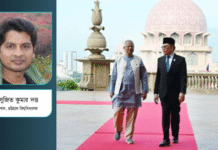Kallol Mustafa
We need to stop the passage of ships through the forest, and halt so-called development projects near the Sundarbans. This is the concluding part of yesterday’s long form
Cleaning up the Sundarbans in a daunting task
There is no saying when the oil slick will be removed from the water and when fish will again be found. What will happen to the livelihoods of the fishermen in this situation? Who will feed their families?
Nothing has been heard regarding relief efforts for these affected people. Who knows, perhaps the government is thinking that if it can keep the forest-dwellers starving in this manner, more of them will be motivated to use their bare hands, and their kitchen pots and pans to extract the oil and sell 30 litres each to the Padma Oil Company!
However, the people didn’t get the idea of collecting the thick layer of oil this way from the government, instead, witnessing the inaction of the government and motivated by the desire to save their beloved Sundarbans, they came up with this way of soaking up the oil themselves and storing it in polythene bags in the soil.
On observing their efforts, the government people then came up with the idea of paying them to clean up the oil in this way.
Now the question is: Is it possible to clean up the whole pollution of the Sundarbans by picking up the oil by hand in this way? Was this the only way of extracting the oil?
Who was worrying about the health risks of the ones who are using their bare hands to extract the oil? Would the members of the Forestry Department, the Secretariat of Environment, the coastguard, and the navy be willing to extract the oil with their bare hands, eschewing the use of gloves and other protective body covers?
What was the point of endangering the health of the people in order to save the health of the environment? If the oil was to be extracted in this manner, why were the people being used to do this job instead of using the various departments of the governments as well as the manpower of the armed forces?
Even if it turns out that, by taking advantage of this spontaneous effort by the people, we could extract the thick layer of oil that had collected on the banks of the waterways, what would happen to the thin layer of oil that was floating on the rivers and canals spread across an area of 80 to 100 square kilometres?
Or how would the oil be extracted that has seeped into the muddy earth which is regularly flooded by high and low tide?
There was talk of using a Chinese-made oil dispersant spray called Lloyed-2.
These chemicals are usually used to fight oil pollution on open seas. It’s not advisable to use such chemicals on mangrove wetlands without carefully considering their effects, as their application may cause even more unforeseen harm than benefits.
We spoke to Sundarbans specialist Dr Abdullah Harun from the Department of Environment at the University of Khulna about what steps should be taken to rid the Sundarbans of the oil. According to him:
First, the heavy oil that had collected in the canals have to be removed. But to achieve this, we shouldn’t depend on the spontaneous efforts of the people, but rather, employ the various governmental agencies and members of the armed forces in an organised way.
And to extract the oil, sponges and other oil absorbent material and instruments should be used in addition to using hands.
Second, before deciding to use chemical sprays to remove the floating layer of oil, we need to consider many things.
One cannot afford to lose time reaching this decision however, and the work of extracting oil using sponges and other absorbent material and vacuum machinery by the governmental agencies and members of the armed forces must begin as soon as possible.
Third, steps must be taken to extract the oil from the layer of mud that is regularly flooded by the tides, if necessary 4-5cm of soil must be extracted to achieve this.
Fourth, the oil that had collected at the base of the trees must be removed. If bare hands are used to clean the oil stuck at the base or the breathers, it may cause much damage.
The scale of danger will not become apparent right away, as we have seen from incidents of oil spills in mangrove forests in other countries in the past, it takes several weeks or even several years for the effects of the pollution to become fully manifest.
It may take a mangrove forest several decades or even half a century before it recovers.
What the Sundarbans will look like in the near future depends on the number of trees and animals that have fallen victims to the oil pollution, and also on how much of it has been affected and to what extent, and lastly, on what remedial steps are being taken.
However, the recent (lack of) actions by the government don’t give us any reason to be hopeful.
A government which has turned deaf ears to repeated requests to stop all traffic of ships carrying dangerous cargo through the Sundarbans, who, despite strong protests, is planning to build two coal-based power plants in the vicinity of the Sundarbans, the future of the Sundarbans is by no means safe in such a government’s hands.
In the face of this, the only way to free the Sundarbans of the oil, and to ensure that the passage of ships through the forest is banned in the future, and to halt so-called development projects such as the NTPC and Orion Coal Power Plant next to the Sundarbans, is to build strong public pressure on the government to do so.
Source: Dhaka Tribune









